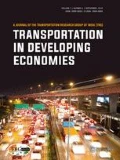Abstract
Indian traffic is typically composed of different vehicle classes like motorized two-wheelers, three-wheelers, four-wheelers, and non-motorized modes, which vary widely in their static and dynamic characteristics. Such diverse group of vehicle classes sharing of the same right-of-way (ROW) results in a type of traffic behaviour called “gap filling” and “virtual lane”. At signalized intersections, this behaviour is manifested by the Probably-First-In-Probably-First-Out (PFIPFO) queuing behaviour, which has been defined and described in this paper. A literature review of the topic reveals that previous delay models have focused on homogeneous traffic conditions and cannot be used for the heterogeneous traffic conditions in countries like India without significant modifications. Basic Webster’s delay model is among the most widely used around the world, including India, for designing and evaluation of signalized intersections. In this model, the signalized intersection is treated as an M/D/1 queuing system with constant (or deterministic) service times and random arrival times. While this is a reasonable model for lane-disciplined, car-dominated traffic, its suitability for the heterogeneous traffic in India is dubious, as the service times are also rendered random in this case by the differences in vehicle characteristics. Hence an M/M/1 or M/M/N queuing model is more appropriate in such scenario. Considering these points, it is therefore necessary to modify Webster’s basic delay model to make it suitable for heterogeneous, weakly lane-disciplined, saturated traffic conditions in India. In the present study, a new model for random delay component using multichannel queuing theory and PFIPFO queuing behaviour is derived for Indian traffic conditions. The proposed model is validated using the results from a micro-simulation and finally it is used to optimize the traffic signal timing for three intersections in Bangalore city.

Source: http://www.google.co.in/imgres


[Source: http://www.google.co.in/imgres]



[Source: http://www.google.co.in/imgres][Source: TAMTAM (2009)]

[Sources: TAMTAM (2009); http://www.google.co.in/imgres]



Similar content being viewed by others
References
Arasan TV, Jagadish K (1995) Effect of heterogeneity of traffic on delay at signalized intersections. J Transp Eng ASCE 121(5):397–404
Cheng D (2003) “Modification of webster’s minimum delay cycle length equation based on HCM 2000”, Transportation Research Board-2003, Annual Meeting, National Research Council, Washington, DC
Fujii H, Uchida H, Yoshimura S (2017) Agent-based simulation framework for mixed traffic of cars, pedestrians and trams. Transp Res Part C: Emerg Technol 85:234–248
Gade D (2012) Traffic signal optimization considering stochastic variability of Indian mixed traffic conditions. M.Tech thesis, IISc, Bangalore, India
Heidemann D (1997) Queueing at unsignalized intersections. Transp Res B 31:239–263
Highway Capacity Manual (2000) TRB, National Research Council, Washington, D.C., 1999
Justo CEG, Tuladhar SBS (1984) Passenger car unit values for urban roads. Transportation B 28B:377–389
Lee TC, Wong KI (2016) An agent-based model for queue formation of powered two-wheelers in heterogeneous traffic. Physica A 461:199–216
LINGO 14.0 (2014) Users’ Manual. LINDO systems Inc., Illinois
Mallikarjuna C, Rao R (2009) Developing and validating a simulation model for heterogeneous traffic. Transportation Research Board-2009, Annual Meeting, National Research Council, Washington, DC
Mathew TV, Radhakrishnan P (2010) Calibration of microsimulation models for non lane-based heterogeneous traffic at signalized intersections. J Urban Plan Dev ASCE 136(1):59–66
May D (1990) Traffic flow fundamentals. Prentice Hall, Upper Saddle River
Metkari M, Budhkar A, Maurya A (2013) Development of Simulation Model for Heterogeneous Traffic with No Lane Discipline. 2nd Conference of Transportation Research Group of India, Elsevier, Procedia—Social and Behavioural Sciences 104(2013) 360–369
Medhi J (2002) Stochastic models in queueing theory. Academic Press
Minh C (2009) The delay estimation under heterogeneous traffic conditions, J Eastern Asia Soc Transp Stud, 7
Raval NG, Gundaliya PJ (2012) Modification of Webster’s delay formula using modified saturation flow model for non-lane-based heterogeneous traffic, Highway Research Journal
Rosca M, Rusca A, A (2012) Methods for green times allocation in undersaturated signalized intersection, UPB Sci Bull, Series D 74(4)
Siddharth SMP, Ramadurai G (2013) Calibration of VISSIM for Indian Heterogeneous Traffic Conditions, 2nd Conference of Transportation Research Group of India, Elsevier, Procedia—Social and Behavioural Sciences 104 (2013) 380–389
Sloboban G, Gordana S, Bratislav L (2008) Optimal traffic control; Urban intersections. CRC Press, Boca Raton
Tamtam A (2009) Multichannel queuing problem approach. Thesis D, FEEC, Brno University of Technology, Antonínská 548/1, 601 90 Brno, Czech Republic
VISSIM5.20 (2009) User Manual. PTV, Germany
Webster FV (1958) Traffic signal settings. Road Research Laboratory; Technical Paper No. 39. HMSO, London
Webster FV, Cobe BM (1966) Traffic signals. Road Research Laboratory (U.K.), Road Research Technical Paper No. 56. HMSO, London
Wong SC, Yang. H (1997) Reserve capacity of a signal-controlled road network. Transp Res Part B 31(5):397–402
Yang H, Bell MGH, Meng Q (2000) Modeling the capacity and level of service of urban transportation Networks. Transp Res Part B 34(4):255–275
Author information
Authors and Affiliations
Corresponding author
Rights and permissions
About this article
Cite this article
Verma, A., Nagaraja, G., Anusha, C.S. et al. Traffic Signal Timing Optimization for Heterogeneous Traffic Conditions Using Modified Webster’s Delay Model. Transp. in Dev. Econ. 4, 13 (2018). https://doi.org/10.1007/s40890-018-0064-2
Received:
Accepted:
Published:
DOI: https://doi.org/10.1007/s40890-018-0064-2




